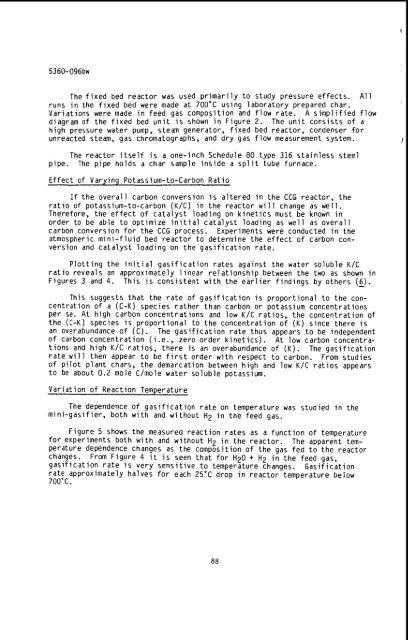the coking properties of coal at elevated pressures. - Argonne ...
the coking properties of coal at elevated pressures. - Argonne ...
the coking properties of coal at elevated pressures. - Argonne ...
You also want an ePaper? Increase the reach of your titles
YUMPU automatically turns print PDFs into web optimized ePapers that Google loves.
5360-096bw<br />
The fixed bed reactor was used primarily to study pressure effects.<br />
runs in <strong>the</strong> fixed bed were made <strong>at</strong> 700°C using labor<strong>at</strong>ory prepared char.<br />
All<br />
Vari<strong>at</strong>ions were made in feed gas composition and flow r<strong>at</strong>e. A simplified flow<br />
diagram <strong>of</strong> <strong>the</strong> fixed bed unit is shown in Figure 2. The unit consists <strong>of</strong> a<br />
high pressure w<strong>at</strong>er pump, steam gener<strong>at</strong>or, fixed bed reactor, condenser for<br />
unreacted steam, gas chrom<strong>at</strong>ographs, and dry gas flow measurement system. I<br />
The reactor itself is a one-inch Schedule 80 type 316 stainless steel<br />
pipe. The pipe holds a char sample inside a split tube furnace.<br />
Effect <strong>of</strong> Varying Potassium-to-Carbon R<strong>at</strong>io<br />
If <strong>the</strong> overall carbon conversion is altered in <strong>the</strong> CCG reactor, <strong>the</strong><br />
r<strong>at</strong>io <strong>of</strong> potassium-to-carbon (K/C) in <strong>the</strong> reactor w i l l change as well.<br />
Therefore, <strong>the</strong> effect <strong>of</strong> c<strong>at</strong>alyst loading on kinetics must be known in<br />
order to be able to optimize initial c<strong>at</strong>alyst loading as well as overall<br />
carbon conversion for <strong>the</strong> CCG process. Experiments were conducted in <strong>the</strong><br />
<strong>at</strong>mospheric mini-fluid bed reactor to determine <strong>the</strong> effect <strong>of</strong> carbon conversion<br />
and c<strong>at</strong>alyst loading on <strong>the</strong> gasific<strong>at</strong>ion r<strong>at</strong>e.<br />
Plotting <strong>the</strong> initial gasific<strong>at</strong>ion r<strong>at</strong>es against <strong>the</strong> w<strong>at</strong>er soluble K/C<br />
r<strong>at</strong>io reveals an approxim<strong>at</strong>ely linear rel<strong>at</strong>ionship between <strong>the</strong> two as shown in<br />
Figures 3 and 4. This is consistent with <strong>the</strong> earlier findings by o<strong>the</strong>rs (a).<br />
This suggests th<strong>at</strong> <strong>the</strong> r<strong>at</strong>e <strong>of</strong> gasific<strong>at</strong>ion is proportional to <strong>the</strong> con-<br />
centr<strong>at</strong>ion <strong>of</strong> a (C-K) species ra<strong>the</strong>r than carbon or potassium concentr<strong>at</strong>ions<br />
per se. At high carbon concentr<strong>at</strong>ions and low K/C r<strong>at</strong>ios, <strong>the</strong> concentr<strong>at</strong>ion <strong>of</strong><br />
<strong>the</strong> (C-K) species is proportional to <strong>the</strong> concentr<strong>at</strong>ion <strong>of</strong> (K) since <strong>the</strong>re is<br />
an overabundance <strong>of</strong> (C). The gasific<strong>at</strong>ion r<strong>at</strong>e thus appears to be independent<br />
<strong>of</strong> carbon Concentr<strong>at</strong>ion (;.e., zero order kinetics), At low carbon concentra-<br />
tions and high K/C r<strong>at</strong>ios, <strong>the</strong>re is an overabundance <strong>of</strong> (K). The gasific<strong>at</strong>ion<br />
r<strong>at</strong>e w i l l <strong>the</strong>n appear to be first order with respect to carbon. From studies<br />
<strong>of</strong> pilot plant chars, <strong>the</strong> demarc<strong>at</strong>ion between high and low K/C r<strong>at</strong>ios appears<br />
to be about 0.2 mole C/mole w<strong>at</strong>er soluble potassium.<br />
Vari<strong>at</strong>ion <strong>of</strong> React ion Temper<strong>at</strong>ure<br />
The dependence <strong>of</strong> gasific<strong>at</strong>ion r<strong>at</strong>e on temper<strong>at</strong>ure was studied in <strong>the</strong><br />
mini-gasifier, both with and without H2 in <strong>the</strong> feed gas.<br />
Figure 5 shows <strong>the</strong> measured reaction r<strong>at</strong>es as a function <strong>of</strong> temper<strong>at</strong>ure<br />
for experiments both with and without H2 in <strong>the</strong> reactor. The apparent temper<strong>at</strong>ure<br />
dependence changes as <strong>the</strong> composition <strong>of</strong> <strong>the</strong> gas fed to <strong>the</strong> reactor<br />
changes. From Figure 4 it is seen th<strong>at</strong> for H20 + H2 in <strong>the</strong> feed gas,<br />
gasific<strong>at</strong>ion r<strong>at</strong>e is very sensitive to temper<strong>at</strong>ure changes. Gasific<strong>at</strong>ion<br />
r<strong>at</strong>e approxim<strong>at</strong>ely halves for each 25°C drop in reactor temper<strong>at</strong>ure below<br />
700'C.<br />
88

















